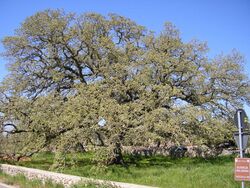Biology:Quercus macrolepis
From HandWiki
Short description: Species of oak tree
| Valonia oak | |
|---|---|

| |
| Example of Q. macrolepis at Tricase, Lecce | |
| Scientific classification | |
| Kingdom: | Plantae |
| Clade: | Tracheophytes |
| Clade: | Angiosperms |
| Clade: | Eudicots |
| Clade: | Rosids |
| Order: | Fagales |
| Family: | Fagaceae |
| Genus: | Quercus |
| Subgenus: | Quercus subg. Cerris |
| Section: | Quercus sect. Cerris |
| Species: | Q. macrolepis
|
| Binomial name | |
| Quercus macrolepis Kotschy
| |
| Synonyms | |
| |
Quercus macrolepis, the Valonia oak,[1] the old name for Quercus ithaburensis subsp. macrolepis.
Geographical range
It is found in the Balkans, and in the southern and eastern Mediterranean, including Albania, the Greek Islands, Turkey, Israel, and Morocco.
Uses

The cups, known as valonia, are used for tanning and dyeing as are the unripe acorns called camata or camatina. The ripe acorns are eaten raw or boiled.[2]
See also
References
Wikidata ☰ Q16919759 entry

